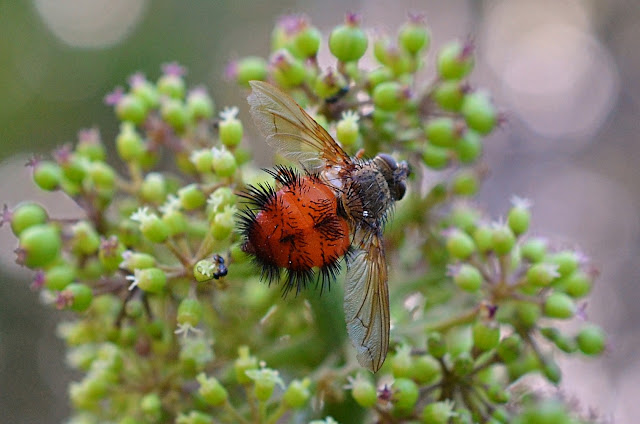I have this Aralia racemosa plant from Ontario wild seed, huge plant like a good sized shrub, but herbaceous ( I actually have two plants, in different beds in slightly different conditions, this is the larger one). It flowers in late summer into fall, with spikes of tiny inconspicuous flowers- boy, do wasps of all sorts (yellowjackets, bald faced, all kinds of strange and cool sorts with loooong ovipositors etc etc) and flies in great variety, among other insects, *love* it! Plus it flowers in late summer into autumn, when other sources of nectar may be scarce. (I think it may be fooling some insects with the scents it emits, but that's a story for another day). Then it makes tiny maroon almost black berries- edible but not too exciting (if the season is long enough- it would prefer longer hotter summers than are the norm, here; another day for that also, sometime when I do a broader post on the plant).
This year, in late September, the yellowjackets and close kin were already petering out, but some other insects still going strong (other kinds of wasps, flies etc). I was stopping by often to look at the parade of life on this plant even as other garden areas were showing less activity, then I saw this amazing creature! First time ever, and probably (?) the same one over a couple of days.
Here's a short video shot at the same time as the photos. Notice all the other often tiny things you see flitting about. There were still many many other insects visiting the plant at this time, probably more posts/videos to come. Spectra video link at bottom of page.
I didn't look it up until recently, but it seems this is a Tachinid fly, a huge family with over 1300species just in North America. There are likely other local species I haven't identified, but we also have another quite common species I'm kind of fond of- like a really robust house fly with golden-orange structures /areas at the base of the wings. The adults of the tachinids are often 'flower flies' mostly nectaring on flowers when not looking for hosts to lay their eggs on/in. They are generally parasitoids or parasites on other insect species, especially caterpillars of moths, but many kinds of insects may be used. This part can be a bit gruesome- parasitoid means they (larvae in this case) consume their hosts, eat them from the inside out, as opposed to parasites which live in or from the host, but do not kill it. This doesn't sound nice, but in fact this interplay of insect species (many small wasps have similar life cycles) is crucial in maintaining balance. If the insects which prey on other insects, in all sorts of ways, were not there, we might find a catastrophic overgrowth of insects that feed on plants. This is one of the reasons why biodiversity is so important and one of the reasons why monoculture agriculture, species poor gardening/landscaping and use of pesticides, herbicides and other harmful substances creates such weak and vulnerable systems. If we want nature to keep itself in balance so that we might have food crops and beautiful gardens and wild areas, we need to nurture the widest possible number of species of plants- including natives, near natives and those exotics which extend seasons and provide food and habitat for the greatest possible number of animal species. That includes insects, reptiles and amphibians, birds, mammals. Underpinning all of this, of course is a strong soil biota in all its many components, including, vitally, fungi.
So I will treasure plants such as this one that support so much life (and all the many other plants in my gardens that host pollinators, predators and even munchers whether a few specialised visitors or endless happy throngs)-- and treasure the sightings of uncommon animals like this one, as well as those seen all season long. My garden definitely has failings- overextension, under weeding! etc, but my greatest feelings of success come in observing all the invertebrate life that makes use of it.
The interesting part of the next image is that we can see part of its proboscis- what we think of as being like a tongue- this extends rather far- to reach food sources such as nectar, and has organs at the end to 'taste' the food and sucking parts to suck the liquid up the hollow centre of the organ.
Here's the Spectra/Peertube Fediverse video link:
You can find me on:
If you are able and would like to support me, I have a Ko-fi page; support helps me keep working-more research, more writing, more art!
(see this post for musings on support sites: https://cohanmagazine.blogspot.com/2021/01/fiction-feedback-and-finances.html ).
As usual, if you love an image, it could be loaded to any of the print on demand sites as cards, prints, mugs, clothing etc. Haven't played with any of those for a while, hope to get back at them soon.






Comments
Post a Comment